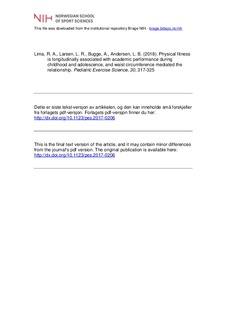| dc.contributor.author | Lima, Rodrigo Antunes | |
| dc.contributor.author | Larsen, Lisbeth Runge | |
| dc.contributor.author | Bugge, Anna | |
| dc.contributor.author | Andersen, Lars Bo | |
| dc.coverage.spatial | Denmark, Svendborg | nb_NO |
| dc.date.accessioned | 2019-02-14T09:06:05Z | |
| dc.date.available | 2019-02-14T09:06:05Z | |
| dc.date.created | 2018-10-11T13:42:34Z | |
| dc.date.issued | 2018 | |
| dc.identifier.citation | Lima, R. A., Larsen, L. R., Bugge, A., & Andersen, L. B. (2018). Physical fitness is longitudinally associated with academic performance during childhood and adolescence, and waist circumference mediated the relationship. Pediatric Exercise Science, 30(3), 317-325. | nb_NO |
| dc.identifier.issn | 0899-8493 | |
| dc.identifier.uri | http://hdl.handle.net/11250/2585376 | |
| dc.description | Accepted author manuscript version (post-print) reprinted, by permission, from Pediatric Exercise Science, 2018, 30(3): 317-325, https://doi.org/10.1123/pes.2017-0206. © Human Kinetics, Inc. | nb_NO |
| dc.description.abstract | Purpose: The current investigation aimed to investigate the longitudinal association between physical fitness and academic performance over 3 years in adolescents. A secondary aim was to determine to what extent waist circumference mediated the association between physical fitness and academic performance. Methods: For the current study, 1020 students from first grade [mean age: 7.87 (0.34) y] to fifth grade [mean age: 11.87 (0.37) y] were monitored annually for 3 years (2010–2013). Physical fitness was assessed using the Andersen test, 5 × 5-m shuttle run, jump height, and grip strength tests and by constructing a composite score combining all 4 fitness tests. Academic performance was assessed by national standardized tests in Danish language and math. Generalized structural equation modeling was used to evaluate the relationships between these variables. Results: The Andersen test (standardized β = 0.15 SD), shuttle run (β = −0.18 SD), jump height (β = 0.10 SD), and the fitness composite score (β = 0.23 SD) were positively associated with academic performance over 3 years. In addition, waist circumference partially mediated the association between physical fitness and academic performance. Conclusion: Thus, physical fitness abilities should be stimulated during childhood and early adolescence because of their positive association with academic performance. | nb_NO |
| dc.language.iso | eng | nb_NO |
| dc.publisher | Human Kinetics | nb_NO |
| dc.title | Physical fitness is longitudinally associated with academic performance during childhood and adolescence, and waist circumference mediated the relationship | nb_NO |
| dc.type | Journal article | nb_NO |
| dc.type | Peer reviewed | nb_NO |
| dc.description.version | acceptedVersion | nb_NO |
| dc.source.pagenumber | 317-325 | nb_NO |
| dc.source.volume | 30 | nb_NO |
| dc.source.journal | Pediatric Exercise Science | nb_NO |
| dc.source.issue | 3 | nb_NO |
| dc.identifier.doi | 10.1123/pes.2017-0206 | |
| dc.identifier.cristin | 1619699 | |
| cristin.unitcode | 203,10,1,0 | |
| cristin.unitname | Institutt for idrett, kosthald og naturfag | |
| cristin.ispublished | true | |
| cristin.fulltext | postprint | |
| cristin.qualitycode | 1 | |
